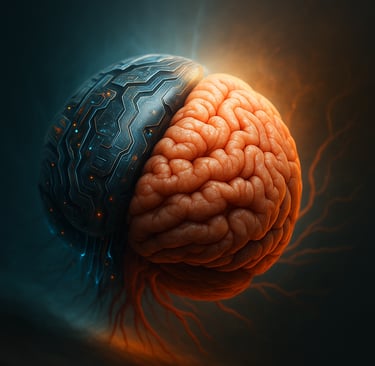Nearing the Dawn of Human-Level AI: Why We’re Closer Than We Think—and What That Means
Microsoft’s AI pioneer claims human-level intelligence is nearing completion, needing only a few breakthroughs; ethical challenges and energy demands must be addressed for safe, practical AI integration into society.
ARTIFICIAL INTELLIGENCETECHNOLOGYAI
Eric Sanders
7/5/20254 min read


Nearing the Dawn of Human-Level AI: Why We’re Closer Than We Think—and What That Means
The Invisible Tipping Point in AI Is Closer Than We Dare Admit
The narrative that true human-level artificial intelligence (AI) remains a distant dream is unraveling faster than most of us thought possible. A top AI pioneer at Microsoft, an industry heavyweight driving breakthroughs behind the scenes, claims that we're only a handful of “miracles” away from achieving human-like intelligence in machines. This isn’t wishful thinking; it's a sober assertion grounded in years of hands-on work with cutting-edge technology.
What’s striking here is not just the proximity to human-level AI but the nuanced understanding that it requires more than just raw computational power or bigger datasets. Achieving this intelligence hinges on a blend of breakthroughs in architecture, reasoning capabilities, and energy efficiency. Meanwhile, the ethical quandaries and environmental costs lurking beneath this progress demand immediate attention. We must recognize both the marvel and the minefield that human-level AI represents, or risk barreling toward an uncertain future blindly.
A Front-Row Seat to AI’s Most Exciting Hour
Having followed AI’s evolution for years, from clunky rule-based systems to today’s fluid, generative models, I’m convinced this moment feels different. Early AI enthusiasts, myself included, have oscillated between grand optimism and sobering skepticism. But Microsoft’s insider perspective emphasizes something I hadn’t fully grasped until now: the gap between advanced AI and human-level cognition is narrower than commonly portrayed.
To put it bluntly, the artificial brain we’re building is not just a calculator on steroids. It’s rapidly becoming capable of reasoning and understanding information with a depth that was science fiction barely a decade ago. Yet, the pioneer is clear in acknowledging the hurdles remaining:
“We only need a few more miracles,” the Microsoft AI expert says. This phrase is telling, there’s no grand overhaul needed, just critical breakthroughs in a few key areas.
Think of those “miracles” as bottlenecks, things like enabling machines to generalize knowledge over broad contexts, developing more natural reasoning processes, and figuring out how to make AI systems energy-efficient enough to deploy at scale without catastrophic environmental impact.
Personally, this balance between potential and challenge resonates deeply. I see AI not as an imminent omnipotent force but as a powerful tool that could revolutionize society if wielded with care. The warning signs about ethical risks and ecological footprints remind me of past tech booms that celebrated progress without foresight. This time, we can choose to integrate transformative AI responsibly—or repeat history’s missteps.
What We Need to Get Right: Ethics and Energy in AI’s Rapid Rise
Human-level AI promises boundless innovation, but all that brilliance will fall flat if it ignores two colossal issues: ethics and energy.
Ethical Challenges
AI systems will increasingly make decisions or offer recommendations with real stakes in people’s lives—from healthcare diagnostics to legal judgments. We must insist on transparency, fairness, and accountability. Otherwise, we invite bias, discrimination, and unchecked power into the very institutions meant to protect us.
- Who owns these AI systems, and whose values do they encode?
- How do we ensure AI respects privacy and human rights tightrope walking the fine line between utility and surveillance?
- What frameworks must we create to hold AI developers and users responsible?
Energy Consumption
Behind every stunning AI demo is a vast, often invisible machine room drawing incredible amounts of power. As models grow larger, energy demands soar, threatening to accelerate climate change and resource depletion.
- Can breakthroughs in energy efficiency keep pace with AI’s hunger for data and computation?
- What role will renewable energy and optimized hardware play in this equation?
- Is the environmental cost of AI progress sustainable, or will it require a fundamental rethinking of how we build and deploy technology?
How to Approach the AI Revolution with Eyes Wide Open
The key takeaway from Microsoft’s AI pioneer is clear: human-level intelligence is within reach, but it is neither inevitable nor harmless. We must approach this moment with deliberate strategy and collective responsibility. Here’s how:
- Stay informed and skeptical: Understand that AI’s capabilities and limits are evolving quickly; don’t be swayed by hype nor dismissive fear.
- Demand transparency and ethical guardrails: Whether you’re a policymaker, technologist, or consumer, advocate for systems designed with fairness and accountability embedded from the start.
- Support sustainable innovation: Encourage investment in energy-efficient AI infrastructure and renewable sources to mitigate the environmental impact.
- Prepare for societal impact: Engage in conversations about how AI will change jobs, privacy, and day-to-day life to create policies that protect and empower people.
- Recognize the human in the machine: See AI as a tool amplifying human potential, not replacing it, and keep human values at the center of technological progress.
AI’s future is a delicate architecture of innovation and caution, getting this balance right defines whether it becomes a miracle or a menace.
What Does It Mean for Us, Right Here, Right Now?
AI is no longer a distant, abstract possibility. It’s progressing toward a level of intelligence that will challenge how we think about creativity, work, and even consciousness. We stand on the cusp of a transformation that demands both awe and accountability.
So the question now is: Who will shape this new era? Will it be the few with unchecked power and proprietary secrets, or the collective of voices refusing to surrender ethical standards? Will AI serve humanity’s highest ideals, or simply fuel unchecked consumption and division?
And maybe the most pressing question is, how will you choose to engage with this profound change?
Because unlike past revolutions that happened to us, the AI revolution is one we can influence—if we listen, learn, and act with intention.
In contemplating AI’s imminent leap to human-level intelligence, we find a mirror reflecting our values and priorities. The future isn’t just a matter of technological marvels; it’s a test of our collective resolve to craft a world where machines amplify human dignity rather than diminish it. The next breakthrough might just be around the corner. Will it be the one that elevates us all?
Efficiency
Transform your workflows and reclaim your time.
Contact Us
Need A Custom Solutions? Lets connect!
eric.sanders@thedigiadvantagepro.com
772-228-1085
© 2025. All rights reserved.
